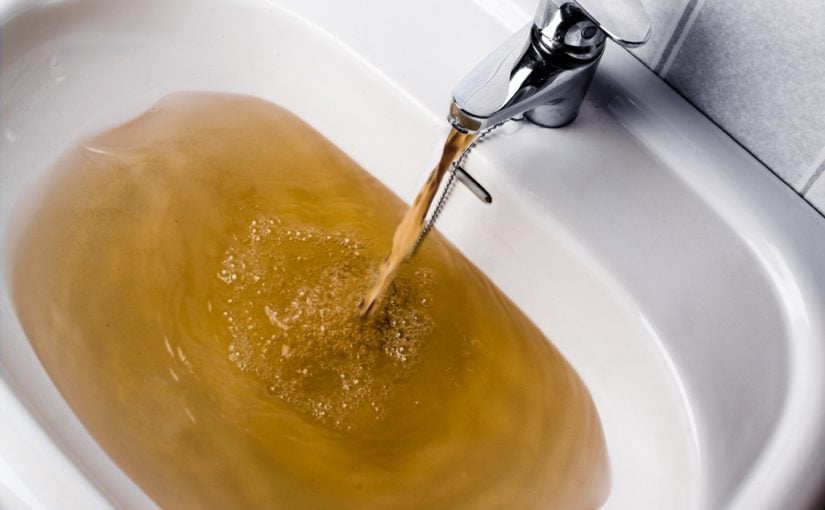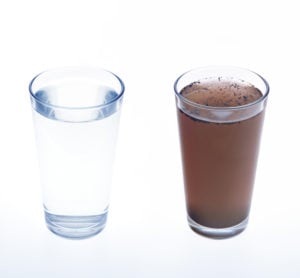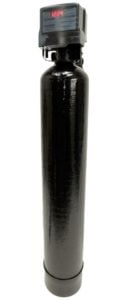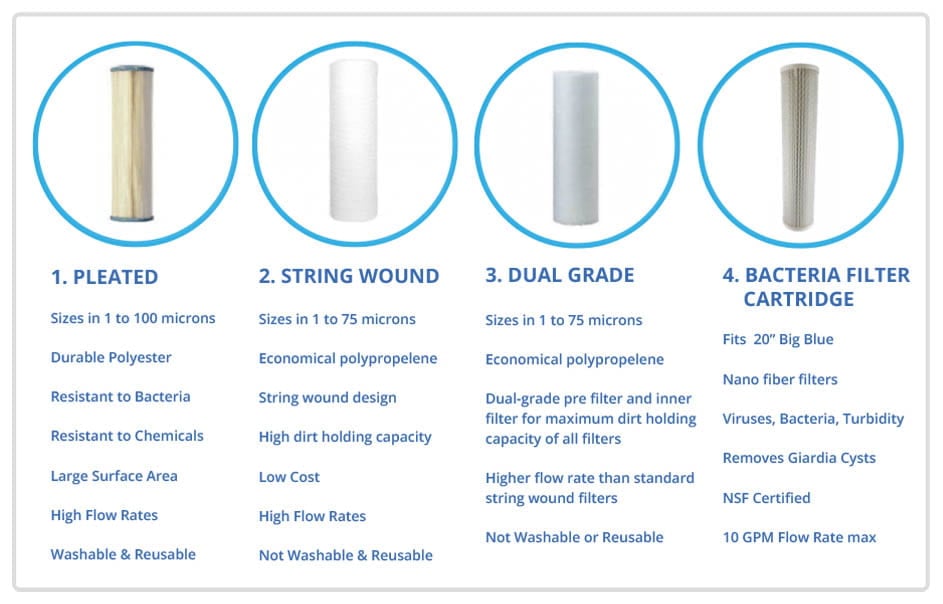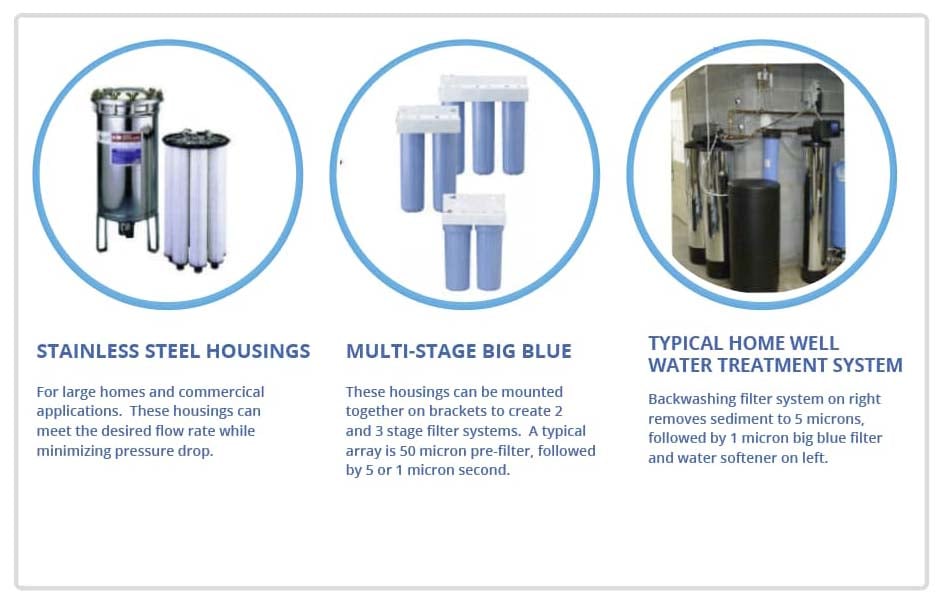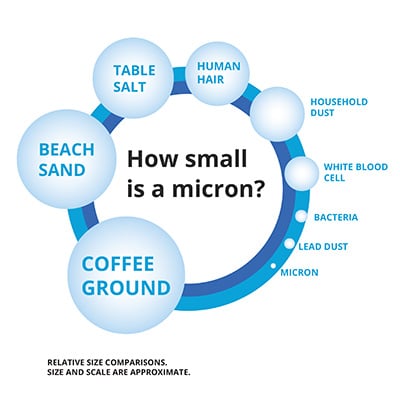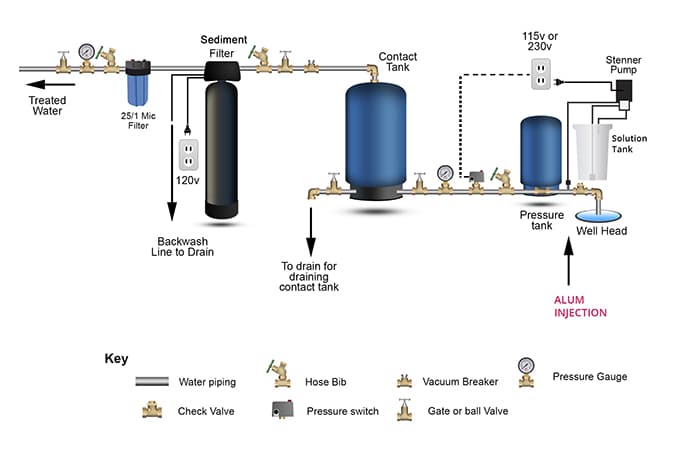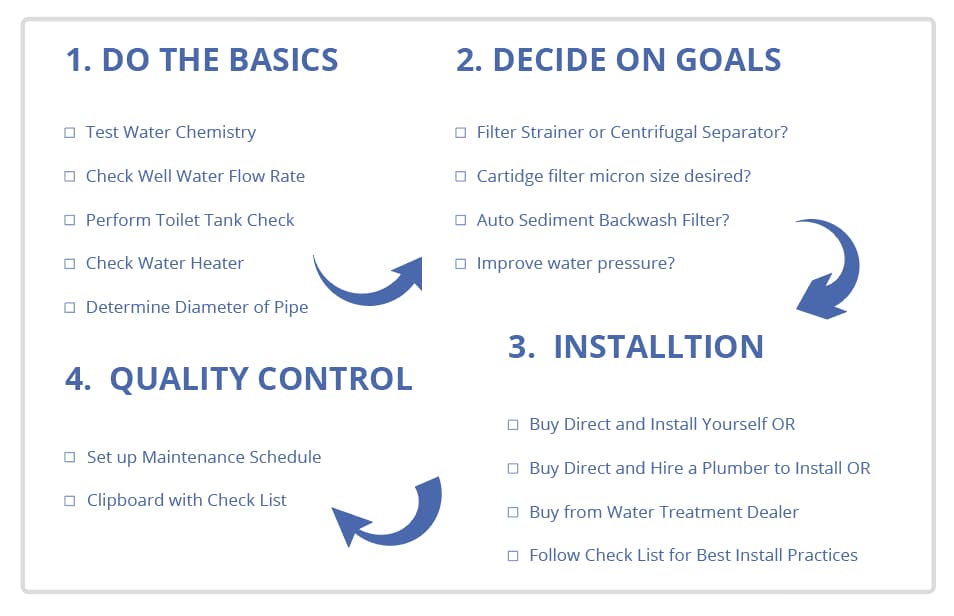Well or spring water can often be full of naturally occurring particles and grit. Sediment in water can clog valves, fixtures, and irrigation systems. Sediment in well water can ruin water heaters and appliances.
How to remove sediment depends on the type and amount of sediment.
Although water-sediment cartridge filters are widely available at hardware stores, these filters are often poorly sized or use the wrong type of filter for the type of sediment that is in the water. The result is often pressure drop, reduced flow rate, and frequent maintenance.
With the correct well water sediment filter for the sediment present, there is a little pressure drop, and maintenance is kept to a minimum. To find the best sediment filter for your well water consider the following types:
There are five main types of sediment filters that are most useful for well and spring water:
- Spin-down filter strainers
- Cartridge filter systems
- Backwashing media filters
- Ultra-Filtration (UF) membrane systems
Questions to Ask When Choosing a Well Sediment Filter:
- What type of sediment do I have in my water system?
- What is the flow rate in gallons per minute that I want to filter?
- What is my line pressure in PSI?
- Which type or combination of types of filtration should I use?
- Do I have sub-micron sediment or turbidity that cannot be filtered out by standard filters and require ultra-filtration or flocculation combined with filtration?
How to Remove Sediment: Test Your Water
It might look like sediment by the time you see it in the toilet bowl or laundry, but often what we think of as sediment is actually dissolved metals such as iron or manganese that turn into a solid particle only after they have entered the household plumbing. A basic water analysis is always a good idea when determining which type of well sediment filter is best for your needs.
A general mineral analysis will provide a list of the common minerals. Important items to test for include:
- pH
- Hardness (calcium carbonate)
- Iron
- Manganese
- Total dissolved solids
Stains and Odors
If water is discolored or has a strong odor, you may also want to test for:
- Iron Bacteria
- Tannin
- Hydrogen sulfide
Professional Analysis or Home Test Kit?
If you are trying to remove sediment in well water or eliminate iron, manganese or odors, home test kits you can do yourself on-site can work very well. The EPA recommends testing your water annually for coliform bacteria and nitrate.
To find a local lab, consult your county health department for recommendations.
The water sample should be drawn as close to the source as possible, before any filtration systems.
Perform a “Toilet Tank Inspection”
Unless your toilet tank is new or has recently been cleaned your toilet flush tank can be a wealth of useful water quality information! Simply lift the cover and look in.
| Symptom | Cause | Solution |
| White scale on float | Calcium hardness | Water softener |
| White scale on float | Total dissolved solids | Reverse osmosis |
| Tank sides are white, but black, rust or sand is laying on the bottom | Decaying galvanized pipes | Replace pipes; correct corrosiveness of water |
| Sand, rust or sediment in well water | Sediment and/or iron filter | |
| Blue Stains | Acidic (low pH) water | Calcite neutralizer or soda ash feeder |
| Rust Stains | Iron | Iron filter (Birm, MangOX, Greensand, Pyrolox) |
| Furry, stringy red growths | Iron (and/or other) bacteria | Chlorination, aeration, ozone injection, hydrogen peroxide, followed by filtration |
| Furry, stringy gray or black growths | Sulfur (or other) bacteria | Chlorination, aeration, ozone injection, hydrogen peroxide, followed by filtration |
| Frothy, with bubbles | Iron bacteria | Chlorination, aeration, ozone injection, hydrogen peroxide, followed by filtration |
| Brown stains | Iron And/or Manganese | Iron filter that removes manganese (MangOX, Greensand, Pyrolox) |
| Black Stains | Iron And/or Manganese | Iron filter that removes manganese (MangOX, Greensand, Pyrolox) |
| Ferric Sulfide (black rust) | Iron filter (Birm, MangOX, Greensand, Pyrolox) | |
| Pink Stains | Airborne bacteria | Not water quality related; Clean with chlorine bleach |
| Water Heater “Sediment” | Caused By |
| Blue or gray chips | Decaying dip tube |
| Black or sandy sediment | Decaying glass liner |
| Black, orange or gray flakes | Decaying anode rod |
It is recommended that you drain your water heater at least once per year. This is not only quick and easy to do, but this will also flush out the sediment that may accumulate in the bottom and give you an idea of the sediment type and color, if any, that are present.
Connect a garden hose to the bottom drain on your water heater and open the valve and run the water into a white 5-gallon bucket.
Check for Pipe Corrosion and Scale Build-up
Your pipes and/or water heater can introduce sediment into your water if they are corroding. Unless your home is new, it is important to check for pipe corrosion scale build-up in the piping. Fortunately, this is not difficult to do by using one of the following methods:
- Check for signs of blue stains in fixtures, blue stains in toilet tanks, which can indicate copper corrosion, and/or test water for copper.
- If you have galvanized iron pipe, look for signs of rust and rust-colored scale in the toilet flush tank.
- If possible, inspect the exterior of pipes and valves, to see if you see any signs of pinhole leaks or corrosion by-products which can be crusty, bluish, white or salty looking or rusty. If you are having any plumbing work done on your house, inspect any sections of the pipes that have been cut to see if there is any scale build-up or signs of corrosion.
| Flakes or Particles | Cause | Possible Remedy |
| Black flakes, grit | The lining of water heater deteriorating | Replace water heater |
| Black grit or particles | Manganese | Greensand filter or MangOX filter |
| Iron sulfide “black rust” | Chlorination with iron filtration | |
| Corrosion from lining of the galvanized pipe | Replace galvanized pipe with copper or plastic pipe | |
| Blue chips | Water heater dip tube deteriorating | Replace water heater |
| Blue or green flakes | Copper-stained calcium particles from copper pipe corrosion | Check pH of water and neutralize acid pH |
| Dirt color sediment | Sediment from well water | Sediment backwash filter, or cartridge type filter; ultrafiltration |
| Gray sand or grit | Sand or dirt from well water | Sediment backwash filter, or cartridge type filter |
| Water heater liner deteriorating | Replace water heater | |
| Red, yellow or orange beads | Water softener resin from a broken water softener | Repair or replace water softener |
| Rust, orange flakes | Rust and iron from well water | Sediment backwash filter, and/or iron filter |
| Iron bacteria | Chlorination with iron filtration | |
| Rust from corroded iron pipes | Replace corroded iron pipes | |
| Sand or grit | Sand from well | Sand separator or Spin-Down filter strainer |
| White or tan flakes | Clay or calcium particles from well water | Sediment filter |
| Calcium carbonate (water hardness) | Water softener | |
| White plastic chips | Water heater dip tube deteriorating | Replace water heater |
| Gray particles suspended in water | Colloidal clay | Ultrafiltration (UF) membrane |
Sediment Filter System Types:
- Mesh screen “spin-down” filter strainers: 100 to the 500-micron range, remove sand and larger sediment
- Micron cartridge filters: 0.5 to the 100-micron range, remove fine sediment
- Sediment backwash filters: filter down to 5 to 10-micron range and are self-cleaning. Often used in conjunction with 1 to 5-micron cartridge filters.
- Ultrafiltration membranes (UF): filter down to less than 0.15 microns. Remove bacteria; very fine colloidal sediment.
Spin Down Filter Strainers
Spin-down filters use screens of varying sizes to remove large sediment and grit from the water. A typical practical size for home water wells is either 60 (250 microns) or 100 (150 microns) mesh.
Mesh Size to Micron Chart
Sediment Backwash Filters
• Removes sediment and turbidity with no filter cartridges or maintenance
• Natural zeolite mineral filters water to 5-micron range
• Auto backwash & rinse keeps media clean
• Little or no pressure drop through the filter
• Rugged media lasts for years
• Lighter than sand but filters finer
• Lower backwash flow rate requirements than traditional sand filters
How to Remove Sediment in Water with Three Stage Approach
Well water first flows through a filter strainer removing sand and large sediment common with silt, dirt, and mud. An optional auto-flush valve keeps the filter mesh screen clean, or it can be manually flushed by opening the bottom flush valve.
Next, the water flows through an automatic back-washing sediment backwash filter where most of the turbidity and sediment are removed down to 5 microns.
Accumulated sediment is automatically flushed out to drain restoring water pressure.
After the sediment backwash filter, the water is further filtered to 1 micron removing all particles over 1 micron.
Micron Cartridge Filters
Filter cartridges are widely used in home water systems and come in a variety of sizes and micron ratings. A micron rating of 50 microns, for example, means that approximately all particles 50 microns in size and up will be trapped by the filter.
Ultra-Filtration Membrane Systems
Some particles are less than 1 micron and cannot be removed by conventional micron filter cartridges. These sub-micron particles can cause water to be cloudy or discolored, or harbor bacteria.
An ultra-filtration or “UF” membrane system filters water down to less than 0.015 microns, effectively removing bacteria, cryptosporidium cysts, and very fine sediment and colloidal clay particles.
The result is crystal clear water with no bacteria or sediment.
UF Systems
• Remove all particles down to the 0.020 to 0.015-micron range.
• Remove turbidity, cysts, and bacteria
• Use Hollow-fiber membrane that is cleaned by simple backwashing
• Require normal line pressure to operate
• Retain natural minerals. Does not desalinate
• Pre-filter water to 1 to 5 microns before UF
Flocculation Aids
Some natural waters contain tannin, organic matter, color, and/or superfine particles called colloids that cannot be practically removed filtration without first pre-treating it with a flocculent. After the non-toxic chemical is injected, it combines with these fine colloidal particles to form ‘floc', which is a larger mass of these particles. The floc is then easily filtered out with auto backwashing sediment filters or cartridge filter systems.
Common Flocculants Include:
• Alum (aluminum sulfate)
• Ferrous sulfate
• Chitosan (from crustaceans)
• Alginates
(If you want to learn more about how to remove sediment in water, check this post out.)
Residential Well Water Flocculation and Filtration System
Sediment Removal Cheat Sheet
Email our technical support department at [email protected] or call us for help at 1-888-600-5426!

